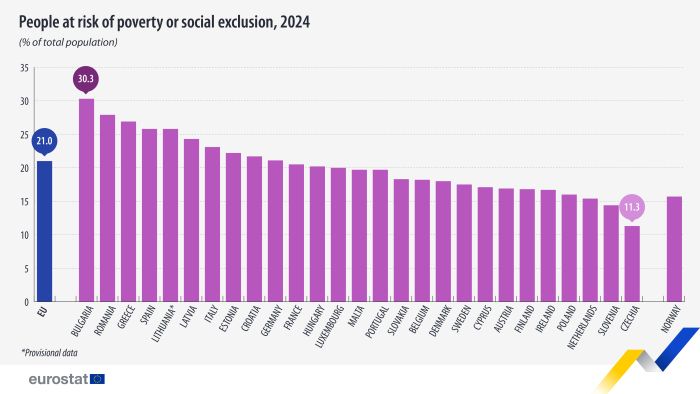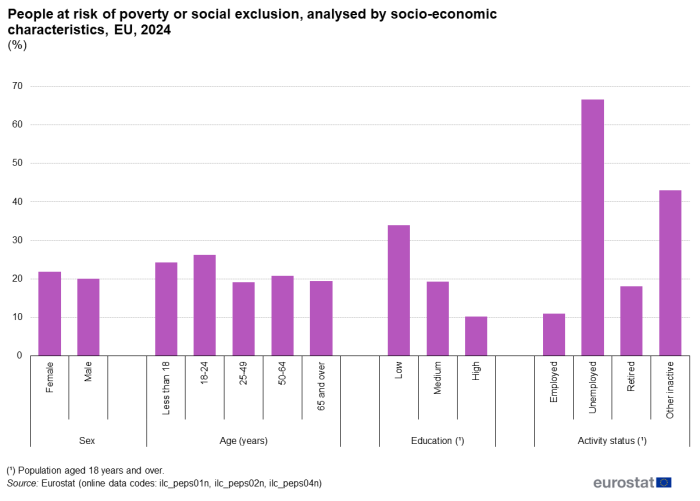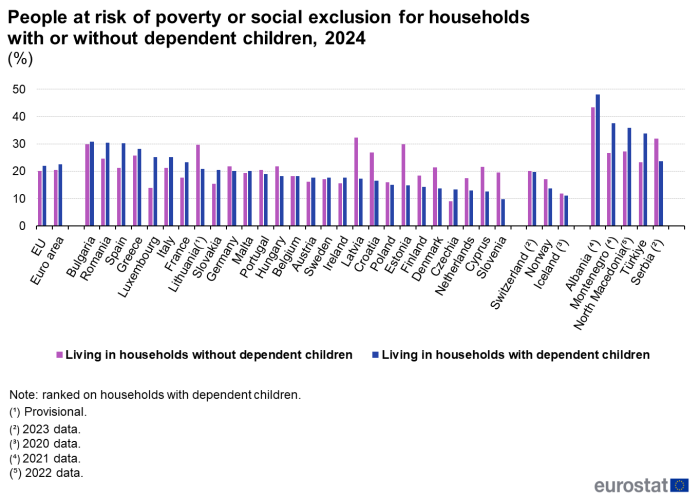Data extracted in: April 2025.
Planned article update: April 2026.
Highlights
In 2024, 93.3 million people in the EU were at risk of poverty or social exclusion; this was equivalent to 21.0% of the EU population.
The risk of poverty or social exclusion in the EU was, in 2024, higher for women than for men (21.9% compared with 20.0%).
In 2024, at the EU level, working status heavily influenced the at-risk-of-poverty-or-social-exclusion rate, ranging from 10.9% for employed people to 66.6% for the unemployed individuals.
Over one-fifth (21.9%) of the EU population living in households with dependent children was at risk of poverty or social exclusion in 2024.

This article is part of a set of statistical articles that form Eurostat's online publication, Living conditions in Europe and focuses on people at risk of poverty or social exclusion, presenting some key results from the European Union's (EU) statistics on income and living conditions (EU-SILC). This data collection covers EU countries, as well as most of the EFTA and candidate countries.
The risk of poverty or social exclusion (AROPE) is not dependent strictly on a household's composition and level of income, as it may also reflect joblessness, low work intensity, working status, or a range of other socio-economic characteristics. To calculate the number or share of people who are at risk of poverty or social exclusion 3 separate measures are combined and this covers those people who are in at least one of these 3 situations
- people who are at risk of poverty, in other words, with an equivalised disposable income that is below the at-risk-of-poverty threshold
- people who suffer from severe material and social deprivation, in other words, those who cannot afford at least 7 out of 13 deprivation items (6 related to the individual and seven related to the household) that are considered by most people to be desirable or even necessary to lead an adequate quality of life
- people (aged less than 65 years) living in a household with very low work intensity, in other words, those living in households where adults worked for 20% or less of their total combined work-time potential during the previous twelve months.
Poverty or social exclusion
Over 1 in 5 people in the EU were at risk of poverty or social exclusion
In 2024, there were around 93.3 million people in the EU at risk of poverty or social exclusion, which was equivalent to 21.0% of the total population. The AROPE rate varied considerably across the EU countries. Bulgaria (30.3%), Romania (27.9%) and Greece (26.9%) reported the highest shares of people at risk of poverty or social exclusion in 2024. By contrast, the Netherlands, Slovenia and Czechia presented shares below 16.0%.
Component indicators which contribute to an analysis of the risk of poverty or social exclusion
Figure 1 provides an analysis for the EU population of the various risks of poverty or social exclusion. Among the 93.3 million inhabitants within the EU that faced the risk of poverty or social exclusion in 2024, some 5.6 million lived in households experiencing simultaneously all three poverty and social exclusion risks. There were 11.4 million people in the EU living both at risk of poverty and in a household with very low work intensity (but not severely materially and socially deprived); 8.4 million were at risk of poverty and at the same time severely materially and socially deprived (but not in a household with very low work intensity); almost 1.5 million lived in households with very low work intensity while experiencing severe material deprivation (but were not at risk of poverty).

Source: Eurostat (ilc_pees01n)
The profile of people in the EU at risk of poverty or social exclusion
Women, young adults aged 18-24 years, people with a low level of educational attainment and unemployed people were, on average, more likely to be at risk of poverty or social exclusion in 2024 than other groups within the EU population (see Figure 2).

Source: Eurostat (ilc_peps01n), (ilc_peps02n) and (ilc_peps04n)
Women and young adults were more at risk of poverty or social exclusion
When analyzed by sex, the risk of poverty or social exclusion in the EU was higher for women than it was for men (21.9% compared with 20.0%).
Concerning age, the highest risk of poverty or social exclusion in the EU was recorded for young adults aged 18-24 years (26.2%), while the lowest risk was recorded for adults aged 25-49 years (19.2%). Moreover, the risk of poverty or social exclusion was 19.4% for people aged 65 years and over and 20.8% among the population aged 50-64 years. The youngest age group, persons aged less than 18 years, also had a relatively high risk (24.2%).
In addition to age, educational attainment had a considerable impact on the risk of poverty or social exclusion
At EU level, more than one-third (33.9%) of all people aged 18 years and over with a low level of educational attainment (International Standard Classification of Education (ISCED) levels 0-2) were at risk of poverty or social exclusion, compared with 10.2% of people in the same age group with a tertiary (high) level of educational attainment (ISCED levels 5-8). The corresponding percentage for people with a medium level of educational attainment (ISCED levels 3-4) was 19.3%.
Unemployed people faced a particularly high risk of poverty or social exclusion
In the EU, 66.6% of the unemployed aged 18 years and over were at risk of poverty or social exclusion in 2024. Inactive people (other than in retirement) faced the second-highest risk on the basis of an analysis by activity status, with 43.0% at risk. For comparison, the share of people in retirement who were at risk of poverty or social exclusion was 18.1% and the share of employed people in such situation was 10.9%.
At the EU level, the risk of poverty or social exclusion for households with dependent children was a little higher than for those without
More than one-fifth (21.9%) of people living in households with dependent children in the EU were at risk of poverty or social exclusion which was slightly higher than the respective share among households without dependent children (20.1%). Nevertheless, these rates varied considerably across the EU countries. For people living in households with dependent children, the rate ranged from peaks of 30.8% in Bulgaria, 30.4% in Romania and 30.2% in Spain down to 13.0% in the Netherlands, 12.7% in Cyprus and 9.8% in Slovenia (see Figure 3). For those living in households without dependent children, the rates varied from 32.3% in Latvia, 29.9% in Estonia and 29.8% in Bulgaria to 15.4% in Slovakia, 13.8% in Luxembourg and 9.1% in Czechia.

Source: Eurostat (ilc_peps03n)
Source data for tables and graphs
Data sources
The data used in this article are derived from EU-SILC. EU-SILC data are compiled annually and are the main source of statistics that measure income and living conditions in Europe; it is also the main source of information used to link different aspects relating to the quality of life of households and individuals.
The reference population for the information presented in this article is all private households and their current members residing in the territory of an EU Member State (or non-EU member country) at the time of data collection; people living in collective households and in institutions are generally excluded from the target population. The data for the EU are population-weighted averages of national data.
The data on educational attainment levels is collected and classified according to ISCED 2011. It is divided into three categories: high (short-cycle tertiary education, bachelor's or equivalent, master's or equivalent, and doctoral or equivalent levels), medium (upper secondary and post-secondary non-tertiary education), and low (less than primary, primary, or lower secondary education).
Tables in this article use the following notation:
| Value in italics | data value is forecasted, provisional or estimated and is therefore likely to change; |
| : | not available, confidential or unreliable value. |
Context
At risk of poverty or social exclusion, abbreviated as AROPE, corresponds to the sum of people who are either at risk of poverty, or severely materially and socially deprived or living in a household with a very low work intensity. People are included only once even if they are in more than one of these situations. The AROPE ratio is the share of the total population which is at risk of poverty or social exclusion. The headline target (EU2030 target) on poverty and social inclusion of the European Pillar of Social Rights Action Plan is to reduce the number of people at risk of poverty or social exclusion by at least 15 million by 2030. Progress towards this target is monitored through the AROPE rate, published by Eurostat.
In 2021, the AROPE indicator was modified. The severe material deprivation rate component was revised, defining a new severe material and social deprivation rate (SMSD) based on a revised list of items, and the low work intensity indicator relating to people living in a household with a very low work intensity was redefined. The revised AROPE indicator is used to monitor the headline target on poverty and social inclusion of the European Pillar of Social Rights Action Plan.
Explore further
Other articles
Thematic section
Selected datasets
Methodology
- Income and living conditions (ESMS metadata file — ilc_esms)
- Income and living conditions — information on data
- Income and living conditions — methodology
External links
Legislation
- Detailed list of legislative information on EU-SILC provisions for survey design, survey characteristics, data transmission and ad-hoc modules
- Regulation (EC) No 2019/1700 — the central piece of legislation for social surveys including EU-SILC
- Regulation (EC) No 2019/2242 — additional central piece of legislation for EU-SILC
- Summaries of EU Legislation: EU statistics on income and living conditions
